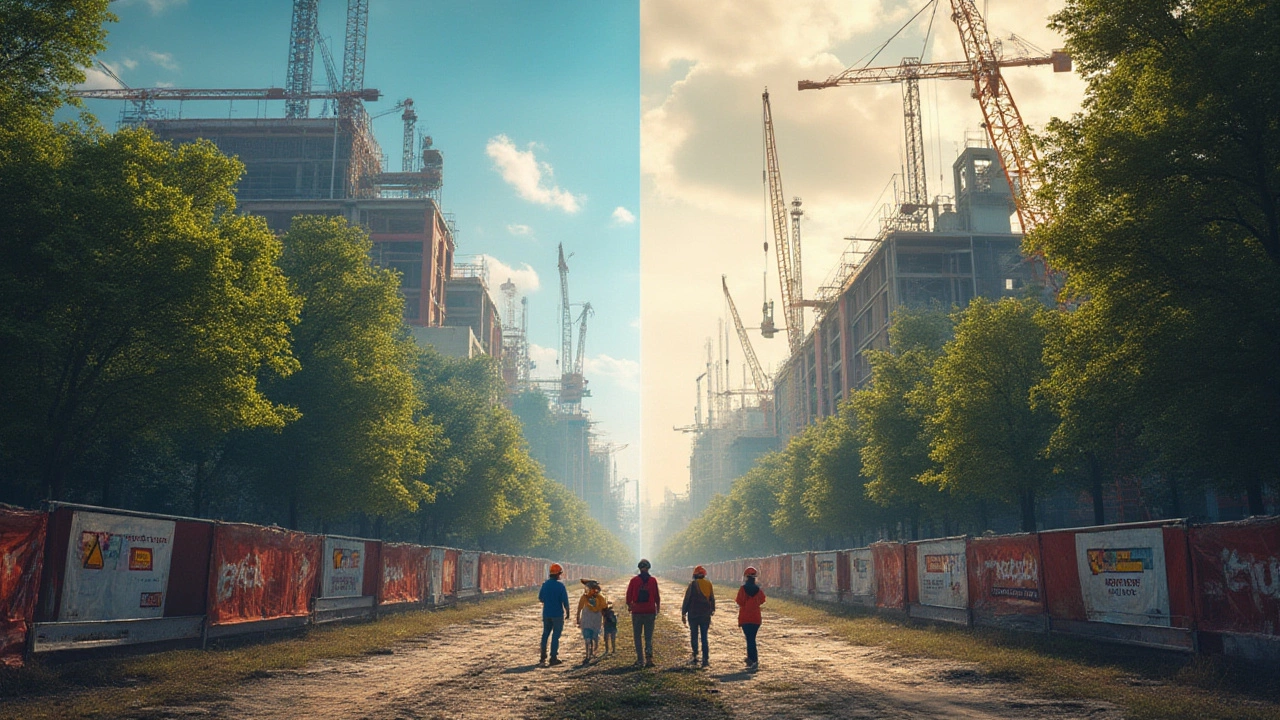Fasten your seatbelt for a wild ride into the world of construction. Imagine standing in the middle of a shiny new office tower, and then in someone’s cozy backyard. Both are considered "construction projects," but they’re nothing alike beyond that label. It’s a bit like comparing flying a jumbo jet to driving your standard sedan; sure, they both get you places, but that’s where most of the similarities end. If you ever thought that building your dream house and putting up a retail plaza involved the same headaches, you’ll want to keep reading. There’s a pile of differences, and some might surprise you more than realizing how much concrete makes up just the foundation of a big box store.
Scope, Scale, and Stakeholders: What Sets Commercial Projects Apart?
First, let's talk size and complexity. Commercial projects are almost always bigger than residential ones, often by miles. We’re not talking about the difference between a doghouse and a two-bedroom bungalow—think huge high-rises, sprawling shopping centers, schools, and warehouses. Even a modest commercial job like a coffee shop can pack more complexity than you’d expect. Most commercial builds involve teams of architects, engineers, planners, and contractors (with a sprinkle of legal and financial pros in the mix). Residential projects, by contrast, often involve just a homeowner, an architect or builder, and the local permit officer. More stakeholders on the commercial side means a traffic jam of opinions, regulatory hoops, and schedules that need more spreadsheets than you can imagine.
Commercial builds juggle timelines where one missed deadline can cost ten times more than a forgotten drywall delivery on someone's house. There’s real pressure to get people working or customers shopping ASAP. That’s why commercial schedules are often managed with project management software that tracks every nut, bolt, and lunch break. Even a slight hiccup can snowball, so detailed planning is the gold standard here.
Let’s talk about the money too. The cost difference is wild: The average U.S. home in 2025 might top out around $450,000 to build, but the median new commercial structure, like a mid-size office, can clock in at $10 million or more. That doesn’t even include the sky-high skyscrapers in major cities, where the construction bill can run to hundreds of millions.
Decisions on commercial projects are less personal and more driven by return on investment. Investors, shareholders, and tenants put pressure on timelines and budgets, leading to strict milestones and frequent updates. By comparison, building a family home often balances budget with emotion—after all, people fight over paint colors, not just profit margins.
Here’s a snapshot of how costs can break down between residential and commercial.
| Type | Typical Size | Average Completion Time | Estimated Cost (2025, USD) |
|---|---|---|---|
| Residential Home | 2,500 sq. ft. | 7-12 months | $450,000 |
| Mid-Size Office Building | 100,000 sq. ft. | 14-24 months | $10,000,000 |
| Retail Strip Mall | 50,000 sq. ft. | 10-18 months | $7,000,000 |
Permitting and codes also come into play. It can feel like there’s a separate rulebook for each side. Commercial buildings must meet stricter fire codes, accessibility standards (hello, ADA compliance), energy ordinances, seismic requirements, and environmental permits. If you think the forms for a residential building permit are tiresome, you’d be amazed by the bureaucracy of a commercial application. Fail one inspection—for example, a sprinkler system—your grand opening can grind to a halt. Tip: Before diving into a commercial build, schedule a meeting with all involved departments early on. You’ll save countless headaches later by mapping out major hurdles before you dig the first shovel.

Construction Standards, Materials, and Methodologies
Materials, methods, and codes split these two worlds apart even further. Commercial projects use heavy-duty materials (think steel framing, reinforced concrete, curtain walls), while residential jobs often run on wood frames, drywall, and asphalt shingles. Even the concrete in a commercial parking garage is tougher—more compressive strength, better durability—than what most homes ever need. That’s driven by higher building codes, fire resistance requirements, longer lifespans, and the huge amount of foot traffic or vehicles expected in a typical commercial building.
Handling utilities is another game-changer. In a home, you need the basics: water, power, gas, and maybe fiber internet. But for commercial spaces? We’re talking about massive electrical loads, specialized HVAC systems that can control the temperature in different zones, business-grade fire suppression systems, freight elevators, and even backup power in the form of gigantic generators. Coordinating all those systems is like conducting an orchestra—one missed note, and you get chaos.
Commercial buildings often need to be open 24/7 or serve hundreds to thousands of people at once, so everything gets upgraded. That’s why it’s not enough to just "pass code"—buildings are inspected for things like load balancing, energy efficiency, and public safety on a level residential folks rarely face. For example, a commercial elevator must meet stricter maintenance schedules and safety inspections than a typical home elevator (yes, those exist!).
Let’s not forget sustainabilty. Commercial spaces face pressure to hit green targets. LEED certification, carbon footprint reporting, and smart energy management are becoming standard. In fact, over 65% of new commercial buildings in the U.S. now pursue some sort of sustainability rating—that number’s up almost 20% from just five years ago. Sourcing recycled steel, using low-emission glass, putting solar panels everywhere—these are all part of the commercial package. Homebuilders might add a solar roof for curb appeal or long-term savings, but commercial developers sometimes face requirements from the city to hit certain environmental benchmarks before they get the green light.
Construction techniques diverge too. Commercial builds often use tilt-up concrete walls, modular construction, or even full structural steel systems. There’s usually a dedicated construction manager or firm who wrangles the chaos, supported by a phalanx of full-time staff and designers. In residential, things run on a smaller crew—sometimes a general contractor with a trusted set of trades, sometimes even a DIY approach for smaller renovations.
The difference in safety protocols is also massive. On a commercial site, workers go through daily “toolbox talks,” wear hard hats, and deal with OSHA reps checking in. Safety records are tracked by insurance carriers, and a single incident can shut a site down. Residential safety is still crucial, but generally not as intensely regulated. Tip: If you’re ever stepping onto a commercial site, don’t even think about skipping that safety briefing or ignoring the hard hat rack—it’s non-negotiable.

Risk, Liability, and Maintenance After the Build
Once the ribbon is cut and people start moving in, the job’s not over—especially in commercial projects. This is where risk, liability, and long-term maintenance hit hardest. Commercial builds are expected to hold up against a far wider range of legal and financial challenges. Imagine a water leak in an apartment vs. a burst main in a hotel. The fallout for a commercial owner is way higher: lost rental income, potential lawsuits, and sometimes city fines.
Commercial property owners carry hefty multi-million-dollar insurance policies, not just for fire and flood, but also liability for accidents, slip-and-falls, and property damage. The fine print can run for dozens of pages. There are specialized inspectors who return every year to check elevators, fire alarms, and sprinklers. Commercial tenants—like restaurants, clinics, or banks—can have "triple net" leases where they, not the owner, pay for taxes, insurance, and upkeep. Residential landlords rarely deal with anything that complex, and homeowners just call a plumber or HOA when the roof leaks.
Building management is a world unto itself for commercial spaces. It’s normal to have full-time maintenance teams, facility managers, on-site security, and cleaning staff. There’s a budget for it—sometimes the size of a small country’s GDP. Residential management might just be a super for an apartment or a friendly local handyman.
Legal requirements follow the same trend. There are constant audits, safety drills, and disaster prep plans in place for everything from fire to active shooters. Someone’s job is to make sure every inspection, insurance certificate, and emergency exit sign is up to date. If something goes wrong—like a data center going offline or a power outage in a hospital—the ripple effects can hit hundreds or thousands of people, not just a single family.
Let’s pull back and look at trends. Back in 2020, remote work drove a boom in home renovations, but commercial work lagged. By 2025, the pendulum swung back. Businesses started betting big on flexible, tech-savvy office spaces to lure workers back. As a result, the commercial sector saw a 12% year-over-year jump in new builds, according to the U.S. Census Bureau. Compare that to just 5% growth in residential. Builders who can move easily between these worlds are in high demand—and make more money, too.
If you’re trying to choose between residential and commercial construction—maybe for your next big project or even a career move—consider the differences in risk, workload, and rewards. Commercial work calls for a literal and figurative hard hat, a thicker skin, and a willingness to handle big money and big problems. Residential work tends to offer more direct satisfaction, but fewer zeroes in the budget. Both can be rewarding if you know what you’re getting into.
Here’s a quick list of tips for anyone thinking of jumping into commercial construction:
- Get familiar with your city’s code enforcement teams. Schedule introductory meetings before submitting permits.
- Invest in project management software from day one—it pays for itself in time and stress saved.
- Build relationships with mechanical, electrical, and plumbing “super subs”—their expertise can make or break your project’s inspection success.
- Don’t skimp on insurance or legal reviews, even if it adds cost. Commercial liability is a different beast.
- Plan for ongoing maintenance budgets when pitching to banks or investors. It’s not just about finishing the build—it’s keeping it running for decades.
Whether you’re managing your first hotel build or just curious why your office looks so different from your house, the world of commercial vs. residential construction is packed with stories, surprises, and—you guessed it—a mountain of paperwork and skill. The good news? With the right information and team, you can navigate either world and maybe, just maybe, enjoy the ride. The biggest difference is knowing where to start and what you’re really signing up for. No two projects are ever the same. And if someone ever tells you they’ve "seen it all," odds are, the next project will prove them wrong.

